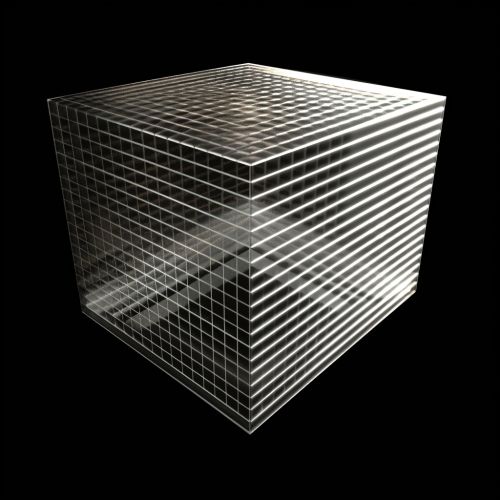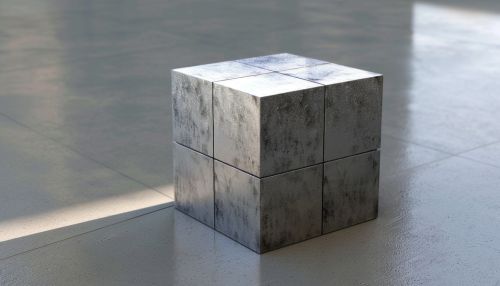Cubic surface: Difference between revisions
(Created page with "== Introduction == A cubic surface is a type of algebraic surface defined by a polynomial equation of degree three in three variables. These surfaces are a central object of study in algebraic geometry due to their rich structure and numerous interesting properties. Cubic surfaces can be classified into various types based on their singularities and geometric configurations. They have applications in several areas of mathematics, including complex geometry, number theory...") |
No edit summary |
||
| Line 51: | Line 51: | ||
* [[Moduli Space]] | * [[Moduli Space]] | ||
[[Image:Detail-92949.jpg|thumb|center|A smooth cubic surface with 27 lines visible.|class=only_on_mobile]] | |||
[[Image:Detail-92950.jpg|thumb|center|A smooth cubic surface with 27 lines visible.|class=only_on_desktop]] | |||
[[Category:Algebraic Geometry]] | [[Category:Algebraic Geometry]] | ||
[[Category:Mathematical Surfaces]] | [[Category:Mathematical Surfaces]] | ||
[[Category:Complex Geometry]] | [[Category:Complex Geometry]] | ||
Latest revision as of 20:17, 21 June 2024
Introduction
A cubic surface is a type of algebraic surface defined by a polynomial equation of degree three in three variables. These surfaces are a central object of study in algebraic geometry due to their rich structure and numerous interesting properties. Cubic surfaces can be classified into various types based on their singularities and geometric configurations. They have applications in several areas of mathematics, including complex geometry, number theory, and mathematical physics.
Historical Background
The study of cubic surfaces dates back to the 19th century, with significant contributions from mathematicians such as Arthur Cayley, George Salmon, and Felix Klein. Cayley and Salmon were among the first to systematically investigate the properties of cubic surfaces, leading to the discovery of the 27 lines that can lie on a smooth cubic surface. Klein further developed the theory by exploring the symmetries and automorphisms of these surfaces.
Mathematical Definition
A cubic surface in projective space \(\mathbb{P}^3\) is defined by a homogeneous polynomial equation of degree three: \[ f(x_0, x_1, x_2, x_3) = 0 \] where \(f\) is a polynomial of degree three in the homogeneous coordinates \((x_0, x_1, x_2, x_3)\). In affine space, this can be written as: \[ f(x, y, z) = 0 \] where \(f\) is a polynomial of degree three in the variables \(x\), \(y\), and \(z\).
Classification of Cubic Surfaces
Cubic surfaces can be classified based on their singularities. The most common types include:
- **Smooth Cubic Surfaces**: These have no singular points and contain exactly 27 lines.
- **Singular Cubic Surfaces**: These have one or more singular points, which can be nodes, cusps, or other types of singularities.
Smooth Cubic Surfaces
Smooth cubic surfaces are particularly interesting due to their geometric properties. They are characterized by the presence of exactly 27 lines, a result first proven by Cayley and Salmon. These lines have intricate intersection properties and form a highly symmetric configuration.
Singular Cubic Surfaces
Singular cubic surfaces can have various types of singularities, such as:
- **Nodes**: Points where the surface intersects itself transversally.
- **Cusps**: Points where the surface has a higher-order tangency.
- **Tacnodes**: Points where the surface has a double tangency.
Properties of Cubic Surfaces
Cubic surfaces exhibit several fascinating properties, including:
- **Intersection Theory**: The lines on a smooth cubic surface intersect in a highly structured manner, with each line intersecting exactly 10 others.
- **Automorphisms**: The group of automorphisms of a smooth cubic surface is finite and can be quite large, depending on the specific surface.
- **Moduli Space**: The moduli space of cubic surfaces, which parametrizes all cubic surfaces up to isomorphism, is a 4-dimensional complex manifold.
Examples of Cubic Surfaces
Several well-known examples of cubic surfaces include:
- **Fermat Cubic Surface**: Defined by the equation \(x^3 + y^3 + z^3 + w^3 = 0\).
- **Clebsch Diagonal Surface**: Defined by the equation \(x^3 + y^3 + z^3 + w^3 - (x+y+z+w)^3 = 0\).
- **Cayley Cubic Surface**: Defined by the equation \(x^3 + y^3 + z^3 + w^3 - 3(x+y+z+w)xyz = 0\).
Applications
Cubic surfaces have applications in various fields of mathematics and science:
- **Algebraic Geometry**: They serve as fundamental objects of study in the classification of algebraic surfaces.
- **Number Theory**: Rational points on cubic surfaces are of interest in the study of Diophantine equations.
- **Mathematical Physics**: Cubic surfaces appear in the study of certain physical models, such as string theory and mirror symmetry.
See Also
- Algebraic Surface
- Projective Space
- Singular Point of an Algebraic Variety
- Automorphism Group
- Moduli Space


